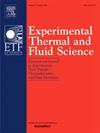Measurements of the vortex structure in the wake of a scale helicopter rotor in forward motion
IF 2.8
2区 工程技术
Q2 ENGINEERING, MECHANICAL
Experimental Thermal and Fluid Science
Pub Date : 2025-04-23
DOI:10.1016/j.expthermflusci.2025.111503
引用次数: 0
Abstract
This paper provides experimental insight into the vortex structures that form in the wake of a scale helicopter rotor in forward motion. Time-resolved stereoscopic particle image velocimetry was used to capture the vortices that form on the advancing and retreating sides of the rotor at an advance ratio of 0.20. The rotor radius was R = 425 mm and its two blades with chord length c = 35 mm spun at 1,500 RPM, resulting in a Reynolds number of UtipR/ν = 1.7 × 106 (Utipc/ν = 1.4 × 105) where Utip is the blade tip speed. The collective, lateral cyclic, and longitudinal cyclic pitch settings were varied one at a time. The structure of vortices measured in the wake was compared to reference paths that we expect the vortices to take if they advect into the wake at a constant velocity without interaction. We find that the vortices on the retreating side of the rotor closely match the reference paths. Conversely, the vortices on the advancing side often exhibited large deviations from the paths. The vortices on both sides of the rotor had opposite directions of rotation when the collective pitch setting was varied. In contrast, varying the lateral and longitudinal cyclic pitch resulted in the formation of vortices with the same direction of rotation on the advancing and retreating sides. Notable vortex formation was observed on both sides of the rotor when the lateral cyclic pitch setting was varied, while vortex formation was dominant on the advancing side when varying the longitudinal cyclic pitch.
大型直升机旋翼向前运动时尾流涡结构的测量
本文提供了实验的见解,形成旋翼尾迹在一个规模的直升机旋翼在向前运动涡结构。采用时间分辨立体粒子图像测速技术,以0.20的超前比捕捉转子前后两侧形成的涡旋。转子半径R = 425 mm,两个弦长c = 35 mm的叶片以1500 RPM旋转,得到雷诺数UtipR/ν = 1.7 × 106 (Utipc/ν = 1.4 × 105),其中Utip为叶尖速度。集体、横向循环和纵向循环螺距设置一次改变一个。将尾流中测量到的涡的结构与我们期望的参考路径进行了比较,如果它们以恒定速度平流到尾流中而没有相互作用。我们发现旋翼后退侧的旋涡与参考路径非常吻合。相反,前进侧的涡旋往往表现出与路径的较大偏差。当总节距设置不同时,转子两侧旋涡的旋转方向相反。而改变横向和纵向旋距,则会在前进侧和后退侧形成旋转方向相同的涡旋。改变横向循环节距设置时,旋翼两侧均有明显的涡形成,而改变纵向循环节距设置时,旋翼前缘以涡形成为主。
本文章由计算机程序翻译,如有差异,请以英文原文为准。
求助全文
约1分钟内获得全文
求助全文
来源期刊

Experimental Thermal and Fluid Science
工程技术-工程:机械
CiteScore
6.70
自引率
3.10%
发文量
159
审稿时长
34 days
期刊介绍:
Experimental Thermal and Fluid Science provides a forum for research emphasizing experimental work that enhances fundamental understanding of heat transfer, thermodynamics, and fluid mechanics. In addition to the principal areas of research, the journal covers research results in related fields, including combined heat and mass transfer, flows with phase transition, micro- and nano-scale systems, multiphase flow, combustion, radiative transfer, porous media, cryogenics, turbulence, and novel experimental techniques.
 求助内容:
求助内容: 应助结果提醒方式:
应助结果提醒方式:


